why doesn’t alice understand what needs to be explained about being a suffragist?
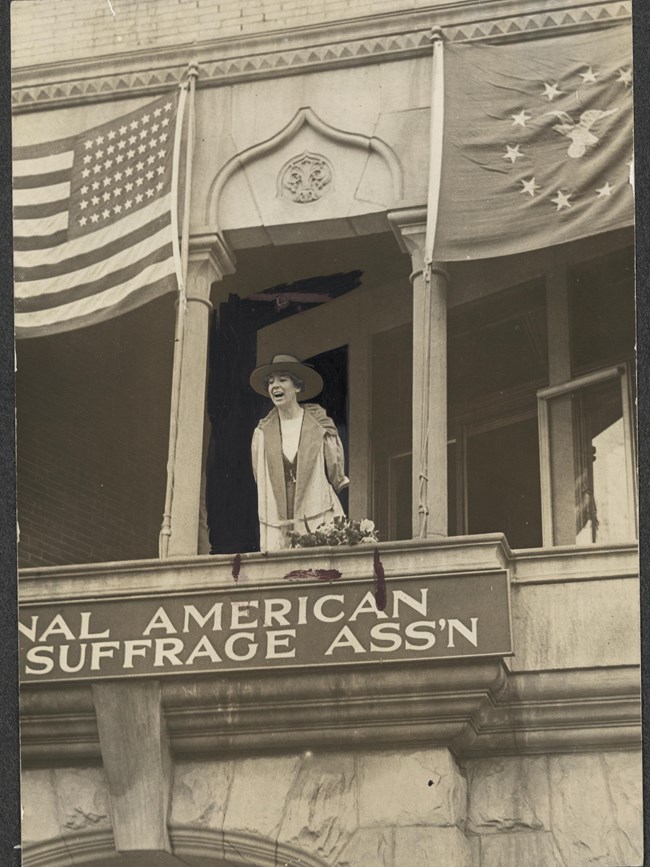
On the forenoon of April ii, 1917, suffragists gathered at the Shoreham Hotel in Washington, D.C. for a celebratory breakfast to honor Jeannette Rankin of Montana. Rankin would be sworn in later that mean solar day as the kickoff woman elected to the U.S. Congress. Beside Rankin on the dais sat ii powerful leaders of the adult female suffrage move. On her left was Alice Paul, founder of the National Woman's Party (NWP). On Rankin'southward right sabbatum the president of the National American Adult female Suffrage Association (NAWSA), Carrie Chapman Catt. Paul and Catt were united on that day in celebration of Rankin's accomplishment. Both had dedicated their lives to the cause of woman suffrage and the fight for equality. Simply in every other fashion, they were securely divided.
A cropped version of the photograph above, taken on the twenty-four hour period of Rankin's swearing in, appeared in the National Woman'southward Party's publication, The Suffragist, a few days later. It accompanied an article titled "Jeannette Rankin Makes Her Kickoff Speech in Washington." If you look closely, you can see that the photo has been altered. Something to the right of Rankin on the balcony has been scratched out.
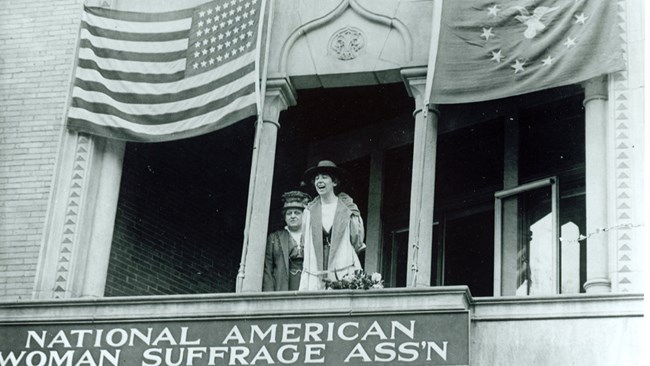
Library of Congress
In the original photo, Carrie Chapman Catt stood on the balustrade with Rankin. Why did the NWP scratch Catt out of the picture? It is possible that it was simply to create a cleaner version of the prototype to accompany the commodity (the ingather marks are also visible on the photograph above.) It is also very likely that the NWP did not want to include Catt in their publication, and Catt probably did not want any association with the NWP and Alice Paul.
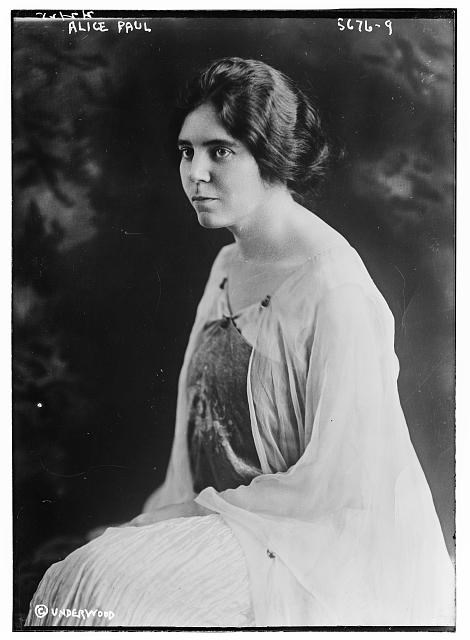
Bain News Service, Library of Congress
The offset disharmonism between Alice Paul and Carrie Chapman Catt came in November 1913 during the NAWSA Convention in Washington, D.C. Paul spoke to the convention about her work as the head of the Congressional Committee raising awareness near the demand for an amendment to the U.S. Constitution ensuring women's correct to vote beyond the state. Paul had organized the Woman Suffrage Procession down Pennsylvania Avenue on March three, 1913, the twenty-four hours before Woodrow Wilson's inauguration. She spoke proudly about her not bad triumph gaining publicity for the movement, every bit well as her successful fundraising efforts. Catt stood upwards during the speech communication and criticized Alice. She defendant Paul of taking also much credit for a motion she had only recently joined. Catt, who had been working for suffrage for decades, implied that Paul was trying to steal power away from the NAWSA leadership and that she didn't know her place.
In a letter to Lucy Burns, co-chair of the Congressional Commission, NAWSA President Anna Howard Shaw summed up the objections to what she and Catt saw every bit the militant tactics of the younger suffragists:
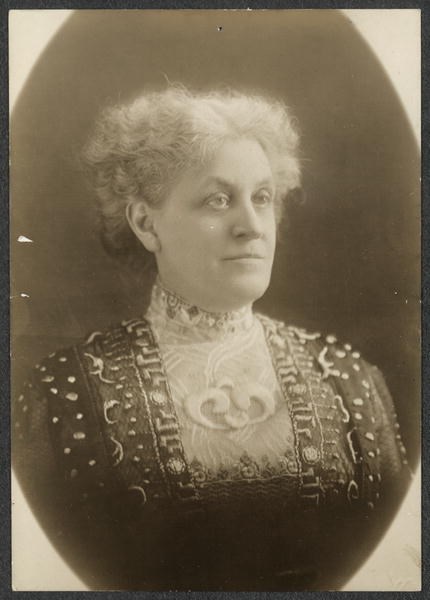
National Woman'southward Political party records, Library of Congress
"Y'all may think we are all a set up of onetime fogies and maybe we are, but I, for 1, thank heaven that I am equally much of an onetime fogy every bit I am…It requires a good deal more than courage to work steadily and steadfastly for 40 or 50 years to gain an end than it does to practice an impulsively rash affair and lose it."
Soon after the public confrontation with Catt, Alice Paul broke away from NAWSA to run her own suffrage association. She founded the Congressional Wedlock for Woman Suffrage which became the National Woman'south Party in 1916. Paul designed the campaigns of the CU/NWP with the intention of gaining publicity and provoking word. She was good at raising money and raising eyebrows, but the membership of her organizations was always a small fraction of NAWSA's membership. The National remained the prominent woman suffrage association across the country.
Catt regularly spoke out in the press confronting the piece of work of the NWP. She believed that the single-minded focus on the passage of a federal subpoena was foolish. NAWSA concentrated on winning the vote on the state level, especially in New York. Without increased support in the states, she believed, the constitutional amendment was doomed to fail. Catt also hated the spectacle of the NWP tactics. Rather than portraying women as respectable, moral citizens worthy of the vote, Catt thought that Alice Paul made suffragists look ridiculous.
For her part, Paul made it a policy never to speak against Catt publicly, merely privately she encouraged women to quit NAWSA and support the NWP exclusively. Catt and Paul met periodically with the intention of working out their differences, only to no avail. During one meeting, having failed to resolve their latest disagreement, Catt angrily stood up and stormed out, leaving Paul with a parting shot:
"I will fight y'all to the final ditch!"
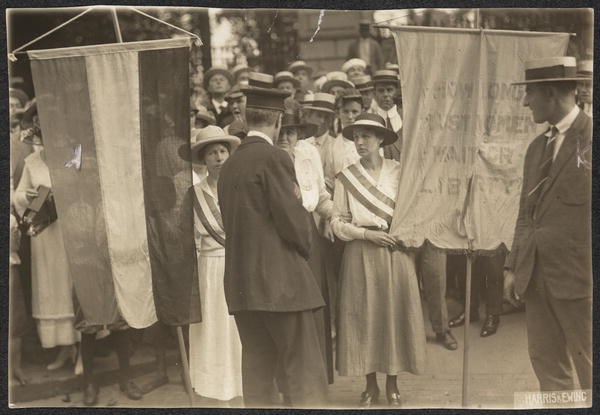
National Woman's Party Records, Library of Congress
The NWP's strategy of relentless confrontation kept the issue of woman suffrage in the news and in public conversation even equally America's entrance into World War I threatened to derail the move. Paul continued with increasingly more provocative campaigns, including the arrest and imprisonment of hundreds of NWP protesters. Catt announced that NAWSA supported the state of war effort, winning influence with politicians and the President through her annunciation of loyalty.
As Catt steered NAWSA'southward efforts more than attentively towards the passage of the federal amendment, she became the more visible leader of the suffragists. When the 19th Amendment was ratified in August 1920, Catt was credited in the press with doing the slow, steady, respectable work that won the victory. Politicians who supported woman suffrage, particularly those who changed their position over time, were oftentimes quick to mention that those troublemakers of the NWP had no effect on their decision.
Carrie Chapman Catt oversaw the transition of NAWSA into a new system, the League of Women Voters. Alice Paul connected her civic engagement and activism besides. The National Woman's Party introduced and lobbied for the Equal Rights Subpoena (which Catt opposed.)
Carrie Catt and her longtime partner Mary Garrett Hay created a memorial in the landscape of their farm, Juniper Ledge, to the women leaders of the suffrage movement. Twelve plaques fastened to trees around the estate honored women like Elizabeth Cady Stanton and Anna Howard Shaw. There was no plaque for Alice Paul.
Sources for this article include: Susan Ware, Why They Marched: Untold Stories of the Women Who Fought for the Correct To Vote (2019) and J. D. Zahniser & Amelia R. Fry, Alice Paul: Claiming Power (2014).
Source: https://www.nps.gov/articles/dyk-alice-paul-carrie-catt.htm
Post a Comment for "why doesn’t alice understand what needs to be explained about being a suffragist?"